#Civita Giuliana villa
Text
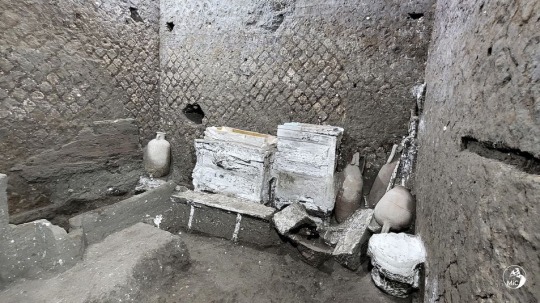
Archaeologists Uncover Slaves Room at Pompeii Villa
Archaeologists have discovered a small bedroom in Civita Giuliana villa near Pompeii that was almost certainly used by slaves, throwing light on their lowly status in the ancient world, Italy’s Culture Ministry said on Sunday.
The room found at the Civita Giuliana villa contained two beds, only one of which had a mattress, two small cabinets, urns, and ceramic containers, in which the remains of two mice and a rat were found.
The room was found at the villa, some 600 meters (2,000 feet) north of the walls of Pompeii, which was wiped out by a volcanic eruption of Mount Vesuvius nearly 2,000 years ago.
“These details once again underline the conditions of precarity and poor hygiene in which the lower echelons of society lived during that time,” the culture ministry said in its statement.
Materials such as furniture and fabric decomposed over time after being covered by the devastating blast of rock fragments, gas, and ash from Vesuvius, leaving a void in the debris. When the plaster is used to fill the void, it reveals the original shape and contours of the long-gone material, including the outline of a crumpled blanket left on the bed netting.
No traces were found of grates, locks, or chains to restrain the room’s inhabitants.
“It seems that control was primarily exerted through the internal organization of servitude, rather than physical barriers and restraints,” said Gabriel Zuchtriegel, the director of the Archaeological Park of Pompeii.
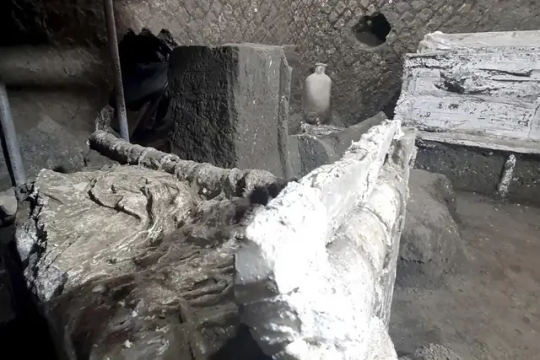

The new room, called “room “A”, is different from the one already known as room “C”, rebuilt in November 2021 in which three cots were positioned and which served at the same time as a closet. What has now emerged suggests a precise hierarchy within the servitude.
While one of the two beds found in recent weeks is of the same invoice, extremely simple and without a mattress, as those of 2021, the other is of a more comfortable and expensive type, known in the bibliography as a “spalliera bed”. Traces of red decorations on two of the backs are still visible in the cinerite. In addition to the two beds, in the recently excavated room there are two small wardrobes, also partially preserved as casts, a series of amphorae and ceramic vases and various tools, including an iron hoe.

The micro-excavation of vases and amphorae from room “C” has in the meantime revealed the presence of at least three rodents: two mice in an amphora and a rat in a jug, positioned under one of the beds and from which it seems that the animal tried to escape when he died in the pyroclastic flow of the eruption. Details that once again underline the conditions of precariousness and hygienic discomfort in which the last of the society of the time lived.
Archaeologists said part of one of the beds had been destroyed by a tunnel used by robbers to access another part of the villa.
Excavations at the Civita Giuliana villa were carried out in 1907-1908, and then again from 2017, when police realized the site was being plundered by illegal diggers.



#Pompeii#Archaeologists Uncover Slaves Room at Pompeii Villa#Civita Giuliana villa#Mount Vesuvius#ancient artifacts#archeology#archeolgst#history#history news#ancient history#ancient culture#ancient civilizations#roman history#roman empire
32 notes
·
View notes
Text
ARCHEOLOGIA / Full immersion nella storia: ecco la "Grande Pompei", un parco diffuso per visitare la città vesuviana, Boscoreale, Oplontis e Stabia
Tutte le aree archeologiche saranno collegate con una navetta gratuita e visitabili con un unico biglietto valido 3 giorni. Riaprono anche le ville di Stabia e l'Antiquarium di Boscoreale.
Tutte le aree archeologiche saranno collegate con una navetta gratuita e visitabili con un unico biglietto valido 3 giorni. Riaprono anche le ville di Stabia e l’Antiquarium di Boscoreale.
Ed eccola, finalmente, la Grande Pompei. Un parco diffuso di cui fanno parte le aree archeologiche di Pompei, Boscoreale, Oplontis e Stabia e tutto il territorio circostante. Un unico biglietto, valido per…

View On WordPress
#archeologia#Boscoreale#Campania#carro di Civita Giuliana#Civita Giuliana#Grande Pompei#Grande Progetto Pompei#notizie#Oplontis#Parco Archeologico di Pompei#pompei#scavi#scavi archeologici#Scavi di Pompei#Stabia#Villa dei Misteri
0 notes
Text
Archaeologists have uncovered Roman slave quarters in a Pompeii villa, revealing a tale of deprivation and hardship 2,000 years ago.
19 notes
·
View notes
Text
The renewed excavations at Pompeii are revealing some fascinating things. Always interesting to see ancient remains as they were left.
21 notes
·
View notes
Text
Los arqueólogos han descubierto barrios de esclavos romanos en una villa de Pompeya, revelando una historia de privaciones y penurias hace 2000 años.
0 notes
Link
Finding at Civita Giuliana villa throws light on lowly status of slaves in ancient worldArchaeologists have discovered a small bedroom in a Roman villa near Pompeii that was almost certainly used by slaves, throwing light on their lowly status...
0 notes
Text
Un carro dell’antica Pompei arriva a Roma
Il carro da parata scoperto nel 2019 a Civita Giuliana, località vicino a Pompei, in una villa suburbana già individuata agli inizi del Novecento e tornata all’attenzione per gli scavi clandestini condotti da tombaroli, è stato restaurato,
Questo carro, con un rivestimento in bronzo e le decorazioni in argento, si presentava agli archeologi in ottimo stato di conservazione e dopo quattro anni dalla scoperta è terminato il lavoro, dove le parti mancanti hanno lasciato varie impronte nella cenere e sono state ricostruite con il calco, in modo che il pubblico possa percepire le sue forme e dimensioni.
L’appuntamento per vedere il carro è la mostra L’istante e l’eternità. Tra noi e gli antichi, in programma fino al 30 luglio 2023 al Museo Nazionale Romano di Roma.
La storia del carro parte nel 2017 quando la Procura della Repubblica di Torre Annunziata, i Carabinieri del Nucleo Tutela Patrimonio Culturale e il Parco archeologico di Pompei decisero di collaborare per fermare il depredamento del patrimonio archeologico dell’area di Civita Giuliana.
Da questa sinergia, che ha visto nel 2019 la nascita di un Protocollo d’intesa per la legalità tra le istituzioni teso al contrasto delle operazioni ì nel territorio vesuviano e dall’attività di scavo, ne è derivata la scoperta di ambienti e reperti di grande valore dal punto di vista storico e scientifico, tra cui il carro cerimonial, con i suoi elementi in ferro, le decorazioni in bronzo e argento con raffigurazioni erotiche, i resti lignei mineralizzati, le impronte degli elementi organici, rinvenuto in condizioni ottime nel porticato antistante alla stalla.
Fu subito chiaro questo manufatto era un unicum in Italia non solo per il livello di conservazione, per le singole decorazioni e la struttura del veicolo, ma anche perché non si configurava come un carro da trasporto per i prodotti agricoli o per le attività della vita quotidiana, già attestati sia a Pompei che a Stabia.
Il carro è identificabile, secondo gli esperti, come un veicolo usato nel mondo romano dalle élite, per cerimonie e per accompagnare la sposa nella nuova casa
Il restauro e l’esposizione non rappresentano solo la restituzione di un reperto eccezionale ai cittadini e agli studiosi, ma anche il coronamento di uno sforzo che ha visto operare insieme Parco archeologico di Pompei, Procura della Repubblica di Torre Annunziata e Carabinieri del TPC, consapevoli del valore del patrimonio, eredità di un grande passato ma anche opportunità di crescita civile e socioeconomica per il futuro.
Inoltre un carro simile era stato ritrovato anni fa in Grecia, nei luoghi dell’antica Tracia, in una tomba appartenuta a una famiglia di alto rango, ma lasciato in sito, mentre questa è invece la prima volta al mondo che questo manufatto viene ricostruito e studiato.
La mostra che espone il carro è promossa dal Ministero della cultura italiano e dal Ministero della cultura e dello sport della Grecia, per testimoniare la centralità e l’importanza della collaborazione tra i due Stati.
E' curato da Massimo Osanna, Stéphane Verger, Maria Luisa Catoni e Demetrios Athanasoulis, con il sostegno del Parco archeologico di Pompei e la partecipazione della Scuola IMT Alti Studi Lucca e della Scuola Superiore Meridionale.
Read the full article
0 notes
Text
Eros e pathos a Pompei, ecco il carro della sposa
Abbracci voluttuosi e amplessi rubati, violenza e piacere che si mischiano, eros e pathos. Restaurato in ogni suo pezzo e assemblato con un’operazione che non ha precedenti, torna in vita dopo duemila anni – documentato in esclusiva dall’ANSA – lo stupefacente carro della sposa ritrovato nel 2021 a Pompei, nel portico della villa di Civita Giuliana, la stessa da dove emersero, grazie ai calchi, i…

View On WordPress
0 notes
Text
A New Archaeological Initiative Scouring Pompeii’s Suburbs Has Turned Up a Fascinating New Cache of Ancient Cookware
0 notes
Photo
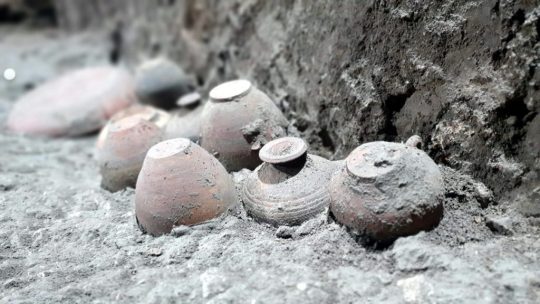
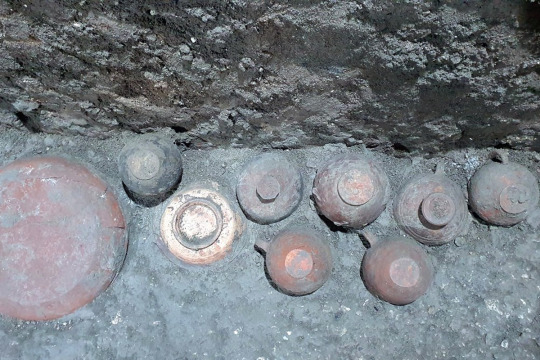




Archaeologists at Pompeii Has Turned up a New Cache of Ancient Cookware
The ancient city of Pompeii has long been celebrated as one of the richest archaeological sites of all time, and now its surrounding suburbs are finally getting their due attention. Researchers have announced new additions to the growing list of unique finds that have recently been made at a nearby villa, Civita Giuliana.
These items of pottery include fired ceramic bowls found upside down along the walls of a room that was likely part of the servants’s quarters within a vast residential complex. It is assumed that this crockery was in situ at the time of the final phase of the eruption of Vesuvius in 79 C.E.
Two years ago, the site made headlines for the stunning discovery of a ceremonial chariot decorated with silver reliefs, a stable containing the remains of a horse still dressed in a caparison as well as evidence of what may have been a small slave family in an adjoining room. In 2020, two bodies that are believed to be a man and a slave attempting to escape the eruption were also found.
The dig began in 2017, but attempts to unearth the secrets of Civita Giuliana have long been impeded by looters who targeted the site as its more remote position left it relatively unprotected.
To counter these illegal excavations, a memorandum of understanding was signed by the prosecutor’s office for the local city and commune of Torre Annunziata and the Archaeological Park of Pompeii in 2019 and renewed in 2021. This unique partnership is the first of its kind in ensuring collaboration and mutual support between archaeological researchers and law enforcement.
“In a territory so rich in history and yet so abused, which still hides important traces of the past, as the discoveries of recent years have shown, it is essential that the protection of cultural heritage and legality go hand in hand,” said Massimo Osanna, former director of the Archaeological Park of Pompeii.
The agreement has allowed supported researchers in a new scientific investigation of the site, which includes stratigraphic studies to reveal details about daily Roman life that aren’t well documented in written sources from the period.
This study has required the closure of a modern road running through the site, which had already been made structurally vulnerable by the elaborate network of underground tunnels made and used by looters. The Civita Giuliana villa will become part of the wider Pompeii system and will eventually welcome tourists.
“These finds demonstrate the commitment and ability of the state to stem the scourge of clandestine excavations and the trade in archaeological goods,” said Italy’s minister of culture Gennaro Sangiuliano. “Pompeii is the pride of Italy and it is our intention to further defend and promote a heritage that is unique worldwide.”
By Jo Lawson-Tancred.
#Pompeii#Archaeologists at Pompeii Has Turned up a New Cache of Ancient Cookware#archeology#archeolgst#pottery#ancient pottery#ancient artifacts#history#history news#ancient history#ancient culture#ancient civilizations#roman history#roman empire
715 notes
·
View notes
Text
ARCHEOLOGIA / Pompei, trovata (e ricostruita) a Civita Giuliana una nuova "stanza degli schiavi"
#ARCHEOLOGIA / #Pompei, trovata (e ricostruita) a Civita Giuliana una nuova "stanza degli schiavi"
Articolo completo con foto e video su Storie & Archeostorie:
@Pompeiisites #archaeology #archeologie
È stato ritrovato, nella villa romana di Civita Giuliana, a circa 600 metri dalle mura dell’antica Pompei, l’arredo di una stanza assegnata agli schiavi. Sembra una fotografia, che denuncia una situazione di precarietà e subalternità. Tuttavia, si tratta di un’immagine di quasi 2000 anni fa, realizzata con la tecnica dei calchi, esistente solo a Pompei e dintorni. Materiali quali mobili e…

View On WordPress
#archeologia#Campania#Civita Giuliana#eruzione Vesuvio#età romana#notizie#Parco Archeologico di Pompei#pompei#scavi#scavi archeologici#Scavi di Pompei#schiavismo#scoperte#stanza degli schiavi
1 note
·
View note
Text
Slave room discovered at Pompeii in 'rare' find
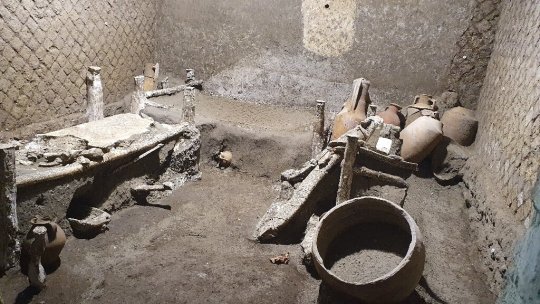
Pompeii archaeologists said Saturday they have unearthed the remains of a "slave room" in an exceptionally rare find at a Roman villa destroyed by Mount Vesuvius' eruption nearly 2,000 years ago.
The little room with three beds, a ceramic pot and a wooden chest was discovered during a dig at the Villa of Civita Giuliana, a suburban villa just a few hundred metres from the rest of the ancient city.
An almost intact ornate Roman chariot was discovered here at the start of this year, and archaeologists said Saturday that the room likely housed slaves charged with maintaining and prepping the chariot. Read more.
453 notes
·
View notes
Link
34 notes
·
View notes
Photo
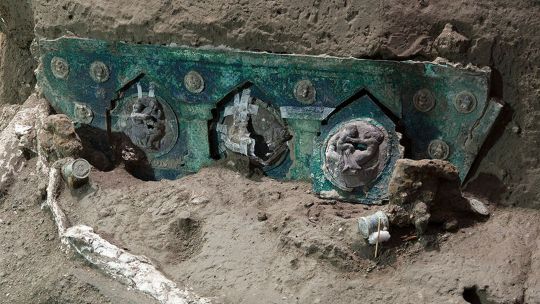

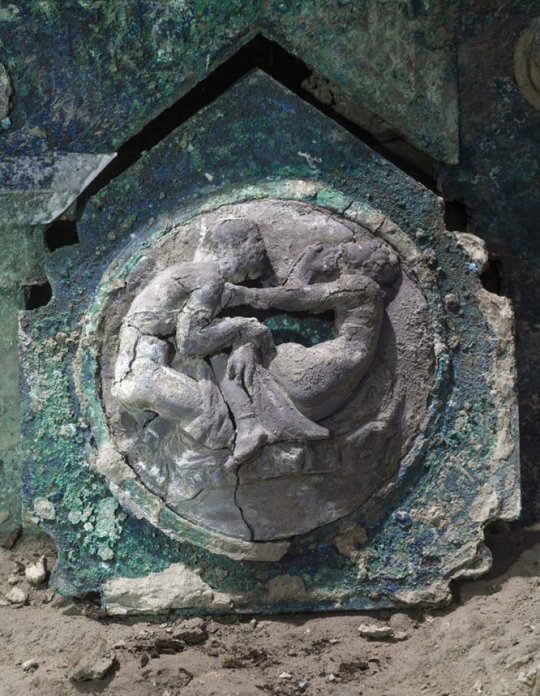

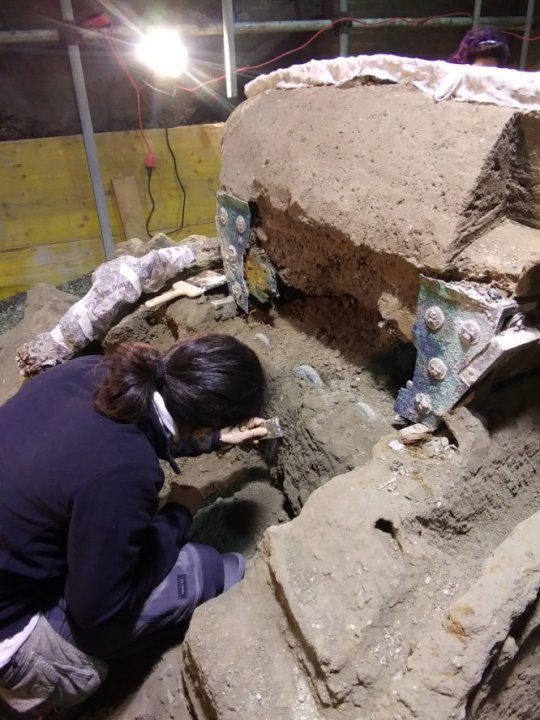
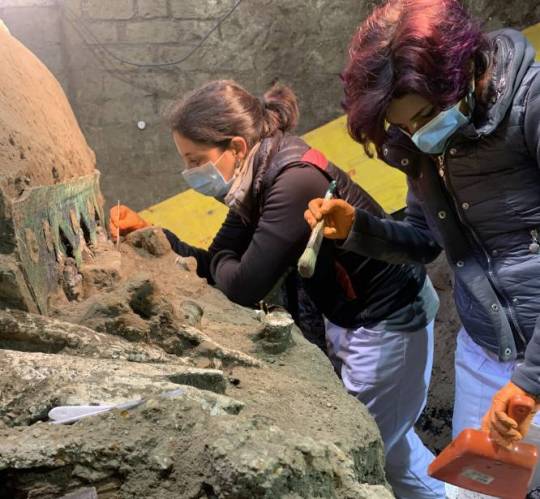
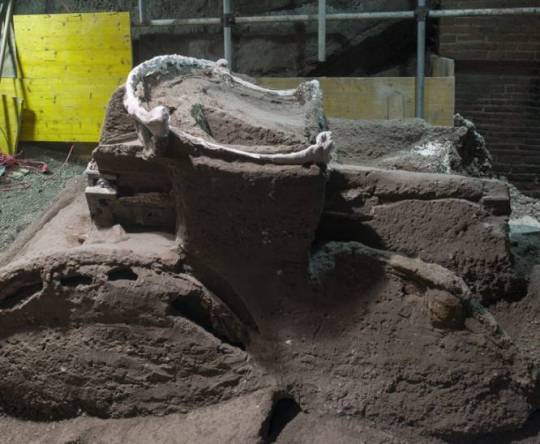


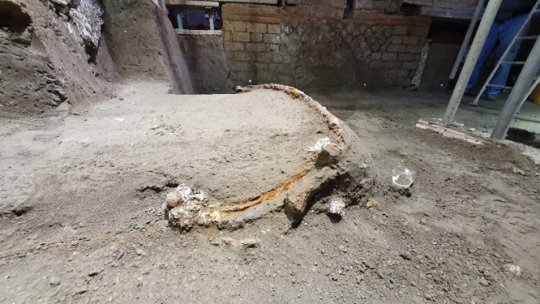
Discovery of a Roman Carriage in the archaeological area of Pompeii.
A large four-wheeled ceremonial chariot, with iron elements, bronze and tin decorations, traces of mineralized wood, and traces of organic elements, such as ropes, has been found almost intact in the Pompeii archaeological area (southern Italy) , the city buried in 79 AD by the eruption of Vesuvius.
It is a carriage, probably the pilentum (with four wheels), which is not used for daily use or for agricultural transport, but to accompany the festive moments, parades and processions of the community.
The discovery occurred in the suburban town of Civita Giuliana, north of Pompeii, beyond the walls of the ancient city.
“It is an extraordinary discovery for the advancement of knowledge of the ancient world”, according to Massimo Osanna, outgoing director of the Archaeological Park, who highlighted that “transport vehicles have been located in Pompeii in the past, such as the one from the House of Menander, or the two chariots found at Villa Arianna, but nothing like the Civita Giuliana carriage”
“Pompeii continues to amaze with its discoveries and will continue to do so for many years to come with 20 hectares still to be excavated. But above all it shows that it is possible to promote it, it is possible to attract tourists from all over the world and at the same time it is possible to carry out research, training and studies”, said the Minister of Culture, Dario Franceschini.
Photos by Luigi Spina (Pompeii Archaeological Park) January 2021
Tex-info by Nat Geo
168 notes
·
View notes
Photo

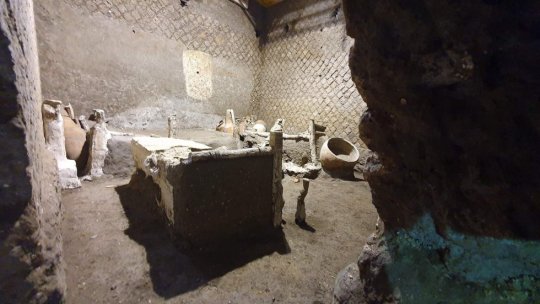
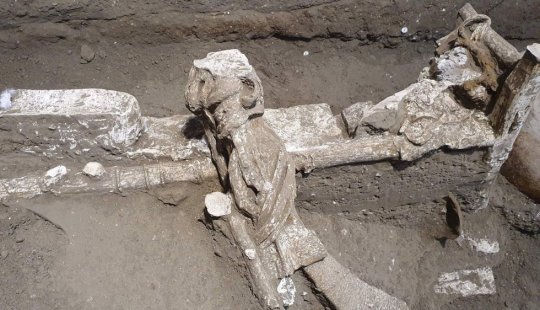



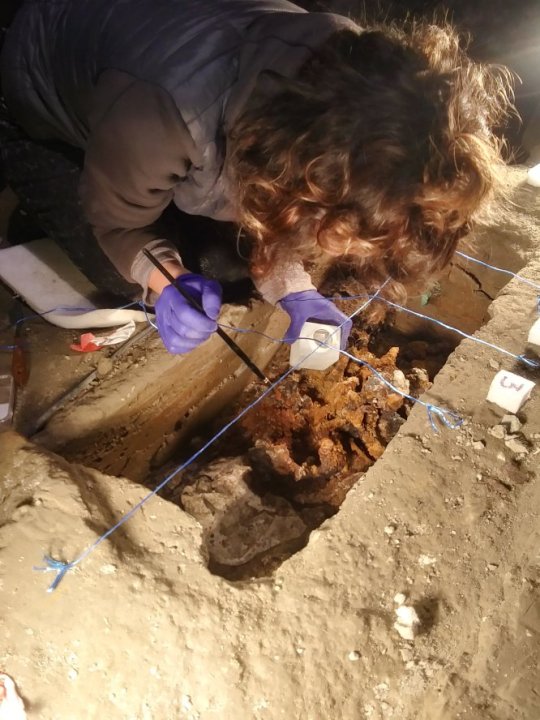
Pompei scopre la stanza di una famiglia di schiavi ben conservata Il team di archeologi che lavora dal 2017 ha scoperto una piccola stanza, in cui vivevano alcuni schiavi, forse una famiglia con un bambino, che si occupavano della manutenzione della villa dei suoi proprietari, ha riferito sabato il ministero della Cultura italiano. La stanza aveva una piccola finestra in alto e mancava di decorazioni alle pareti. Il ritrovamento è avvenuto nell'area del comune di Civita Giuliana, situato a nord di Pompei e che ha già portato alla luce nei mesi scorsi altri ritrovamenti, come un carro cerimoniale quasi intatto o una stalla con i resti di tre cavalli. Questa modesta stanza, in cui si possono vedere resti di vasi e altri oggetti, e ritrovati "in uno stato di conservazione eccezionale", arricchirà "ancora di più la conoscenza della vita quotidiana degli antichi pompeiani" e specificamente di una parte del società, del cui stile di vita si sa poco, ha affermato in una nota il ministro della Cultura Dario Franceschini. Tre brandine di legno e una cassapanca, anch'essa in legno, sono state ritrovate con oggetti metallici e tessuti che gli archeologi ritengono possano far parte di finimenti per cavalli. Due letti sono lunghi circa 1,70 metri, mentre l'altro è solo di 1,40 metri, quindi gli esperti deducono che potrebbe essere un bambino. Al di sotto erano custoditi oggetti personali, come anfore portaoggetti, brocche in ceramica e vaso da notte. "Oltre a fungere da camera da letto per un gruppo di schiavi, forse una piccola famiglia come suggerirebbe la culla a misura di bambino, l'ambiente fungeva da ripostiglio, come testimoniano otto anfore raggruppate negli angoli lasciati liberi per questo scopo" ha spiegato il ministero italiano. Civita Giuliana, che dal 2017 conta archeologi sul territorio. Per anni è stata oggetto di sistematico saccheggio e parte del patrimonio archeologico è andato perduto a causa delle gallerie scavate dai tombaroli che hanno causato un danno complessivo stimato in quasi 2 milioni di euro in tutta la cittadina, secondo i calcoli del ministero italiano. EL PAIS
41 notes
·
View notes
Link
Finding at Civita Giuliana villa throws light on lowly status of slaves in ancient worldArchaeologists have discovered a small bedroom in a Roman villa near Pompeii that was almost certainly used by slaves, throwing light on their lowly status...
0 notes